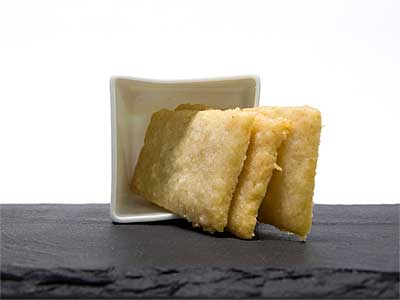August 20, 2012
Mignardise

sablée de noix de coco
(coconut shortbread cookies)
My mother was known for her cookies. By today’s standards they weren’t fancy, but they were always tasty. Whereas as cookies available from the supermarket were either hard as rock and capable of withstanding a nuclear attack or mass-marketed standards such as Fig Newtons, Oreos, Nilla Wafers, and Animal Crackers, my mother’s cookies were soft, crumbly, and handcrafted. They were made with lots of butter. The sugar was always cane sugar from C&H. Some were traditional German cookies, although I’m not sure she ever made any before she left Germany in the early 1930s. Others were modern cookies that she learned from magazines or neighbors. Some were fashioned using a cookie press, some cut from logs made hard from spending the night in the refrigerator, and some were bars. They were stored in tins on the kitchen counter. Later in life when she had a freezer, there was always a stock on hand for any emergency.
When the synagogue needed cookies for a fundraiser or a meeting or the odd Kiddush after Friday night services, the call would go out to my mother for a few dozen. When she and my father would go to their favorite restaurant—one of the most expensive white-table cloth-type in the area—she would bring a tin of cookies, some for her desert and the rest to share with the staff. The only people not recipients of her cookie largess were her sons. In our lunches, there’d be store-bought cookies.
Even though I often saw my mother in the kitchen making cookies, I was never invited to help her. I would like to think that cookie making was a meditation for her, except that I remember her swearing quite often during the process. My mother had studied English in high school in Germany, but it was her journey to the United States that shaped her language for the remainder of her life. She was the only passenger on a British freighter that sailed from Rotterdam to San Francisco via the Panama Canal. She was 17 at the time. Her brother, who was three years older, had accompanied her from Munich to Rotterdam, but from then until she was met by her aunt on the San Francisco dock, she was the only woman traveling with a group of British sailors. She always spoke kindly of the sailors, but their way of talking, especially the swearing, informed her speech the remainder of her life. And when in the kitchen making cookies, she seemed to be reliving old times.
My mother passed none of her cookie making skills, recipes, or (cookie) love down to her sons. I enjoy a good cookie now and then, especially with one of my five or six espressos during the day. But to hunker down and turn out a few dozen cookies is not my favorite activity. About all I picked up from my mother’s cookie making skills was the colorful language that accompanied it. Therefore, it is curious that so many of my mignardise creations are cookies. Maybe it’s because they freeze well? Even some very conservative recipes still make enough cookies to end months of dinner parties. It’s easy to throw a mignardise plate together at the last minute if there’s a variety of frozen cookies available.
When I run across cookie recipes, I think long and hard if I want to add another to the collection. The following recipe made the pass because the concept of a coconut shortbread got me curious and sounded interesting. I found it on Eddy van Damme’s website, and although it made over four dozen cookies, even after I prepared only a third of a recipe, I decided it was worth keeping.
167 g (1-1⁄2 sticks)
soft, unsalted butter
70 g (1⁄2+ c)
powdered sugar
2⁄3 t
vanilla extract
1 t
fine salt
1 extra-large
egg yolk
70 g (2-1⁄2 oz)
desiccated coconut
180 g (1-1⁄4 c)
pastry flour
1. Place the butter, sugar, vanilla extract, and salt in a bowl, and mix with a wooden spatula until just combined. Mix in the egg yolk followed by the coconut. Add the flour in one batch, and mix until just combined. Wrap tightly in plastic wrap and refrigerate overnight or for two days.
2. Preheat oven to 180 °C (355 °F).
3. Roll the dough to a thickness of 3 mm (1⁄8 in). Cut into 2.5 by 5-cm (1 by 2-in) cookies and transfer to a baking sheet prepared with parchment paper or a silicone liner. Bake until golden, about 10 minutes.
© 2012 Peter Hertzmann. All rights reserved.
